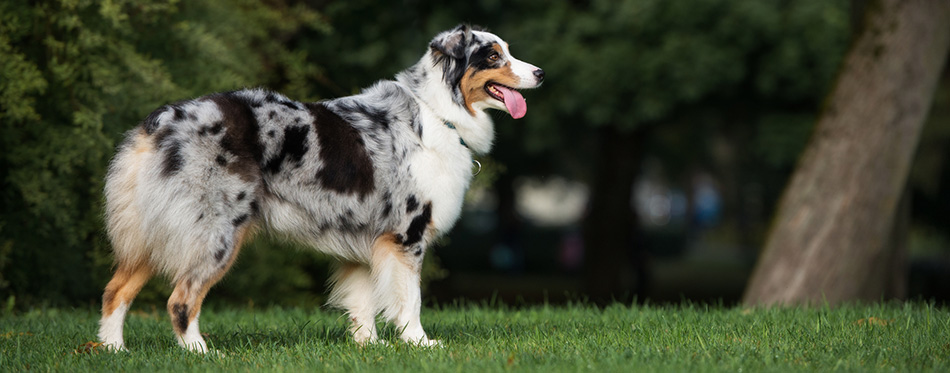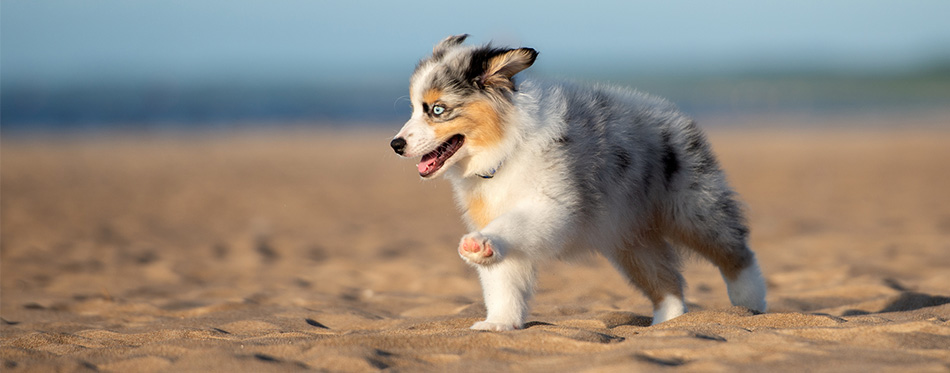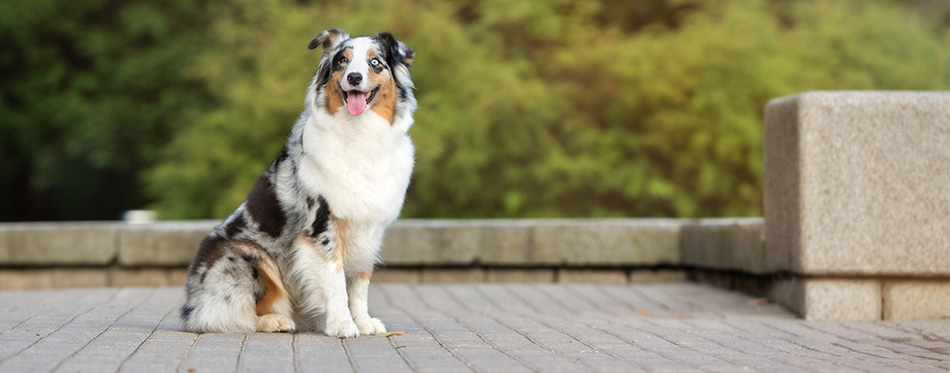Energetic, intelligent, beautiful and hard-working, the Blue Merle Australian Shepherd, also known as simply Australian Shepherd, is a wonderful family pet, who despite its name, has American roots. Originally bred to herd sheep and other livestock, this is a working dog at heart who is happiest when there’s a job they need to do. The Blue Merle Aussie also has unrivaled intelligence and is easy to train, which is why they make for great police and military working dogs and competitors in obedience competitions. If you have children, this may be the ideal dog breed to get – the Aussies just love to romp with kids, yet they’re gentle and easy-going! But like any breed, the Australian Shepherd does have some hard-to-manage traits and quirks; for instance, they require plenty of daily exercise and lots of space to run freely. They are highly active dogs who need to be kept busy, so they’re definitely not suitable for sedentary pet owners. In short, they’re not for everyone! But if you want a smart, trainable, friendly and highly active canine companion, you’ve found it.

History of the Blue Merle Australian Shepherd
The history of the Blue Merle dog breed is not as clear as we might like it to be due to its misleading name. Despite the “Australian” part, this breed is actually an American-born dog that is descended from a line of Europe’s dog herders. It was originally created to herd livestock for farmers and ranchers in the western U.S., and to this day, there are many Aussie Shepherds that still hold the herding job.
But what breeds were used to create the Blue Merle Aussie Shepherd? As mentioned, the history is quite vague here and there are many theories regarding the origin of the Aussie. That said, the breed’s ancestors likely include collie and shepherd-type dogs that were brought in with sheep from Australia in the middle of the 19th century (hence the name!). Wanting to refine their herding and working dogs, breeders created the Australian Shepherd as we know it today, who is versatile, hard-working and smart.
If you’re interested in a more detailed history report of the Blue Merle Aussie, the American Kennel Club writes that the breed’s first steps began in Europe, in the borderlands between Spain and France. Here, the indigenous people known as the Basques worked as shepherds with their herding dogs. These were called Pyrenean Shepherds because the area where the Basques lived was near the Pyrenees Mountains.
In the early 1800s, many Basques – with their Pyrenean Shepherds in tow – went to Australia to try their shepherding luck on the new, green continent. There, the Basques refined their faithful dogs with judicious crosses to Australia’s British imports, Border Collies and Collies, among others. Years later, the Basques left Australia and went to America, California. There, the American ranchers and farmers welcomed the Basques, their sheep flocks and herding dogs, admiring their excellent shepherding capabilities. Because the Basques and their canine companions came from Australia, Californian ranchers assumed the dogs were an Australian breed. And that is how this beautiful dog got its name, the Australian Shepherd.
In America, Aussie Shepherds were further refined and perfected, after which they became irreplaceable companions of the cowboys. But it wasn’t until 1993 that the Australian Shepherd entered the AKC Herding Group. Today, many Aussies are happily herding in the American West, while others are working as therapy dogs, service dogs, police drug detectors, even rodeo performers.
Quick Facts About the Blue Merle Australian Shepherd
While the Aussie dogs are hard-working, intelligent and friendly dogs, they do come with potential health issues as well as temperament quirks that may make them unsuitable for certain pet parents. Here are some quick facts about the Blue Merle Australian Shepherd dog that you need to know before adopting one.
- The Aussie is a highly athletic and energetic dog that needs plenty of daily exercise to stay healthy, both physically and mentally. If they don’t get between 30-60 minutes of exercise a day, they can become unhappy, destructive and bark for long periods of time.
- Because this is a working dog breed, the Australian Shepherd is the happiest when it has a job to do. Don’t worry if you don’t own sheep though – the Aussie is happy guarding the home and having some consistent daily activities (such as walking too), but watch out for them trying to shepherd your other dogs or children!
- The Aussie comes in many different colors, each of them unique-looking and beautiful. The recognized colors are solid black, solid red, blue merle, and red merle. What is a merle, you ask? It’s a genetic pattern in a dog’s coat that comes in various patterns, including mottled patches or a solid or piebald coat. It can also be expressed through blue or odd-colored eyes. While the Australian Shepherd colors may vary, the breed’s general temperament remains pretty consistent!
- The Aussie is an intelligent, clever dog that is easy to train. That’s why they’re often used as police, narcotics and search and rescue dogs, as well as aids to physically handicapped people.
- You may have noticed that some Aussies have docked tails – this is not done for cosmetic reasons, but practical ones. Because Aussies are a working breed who often work on ranches and farms, some owners choose to dock their pets’ tails to avoid injury or to identify them as working stock. That said, some Aussies are born with naturally bobbed tails.
- They have medium-length double coats that come in straight and wavy varieties. Regardless of your Aussie’s coat color and wave pattern, you can expect to brush them one to three times a week as they shed quite a bit.

Things You Should Know
While generally a healthy, smart and friendly breed, the Australian Shepherd is not a perfect dog (but then again, which breed is?!). Before getting an Aussie, it’s important to be aware of the dog’s health, how trainable they are, how much exercise they need on a daily basis, what diet suits them best and so on. Here, we cover everything an aspiring Australian Shepherd owner should know.
Health
The Aussies are generally a healthy breed, but they’re not immune to developing genetic health problems and diseases. For instance, vision problems are common and so is epilepsy. Here is a list of diseases and health problems to watch out for:
- Hip dysplasia
- Elbow dysplasia
- Epilepsy
- Progressive Retinal Atrophy (PRA)
- Collie Eye Anomaly (CEA)
- Cataracts
- Deafness
- Osteochondrosis Dissecans (OCD)
- Hypothyroidism
- Multiple Drug Sensitivity (MDS).
To avoid serious health issues, make sure you’re buying (if buying, of course) from a good, reputable breeder who tests for genetic diseases and can show you health clearances for both of the puppy’s parents. Demand healthy clearances from:
- The Canine Eye Registry Foundation certifying that the dog’s eyes are normal
- The Orthopedic Foundation for Animals for hip and elbow dysplasia, hypothyroidism and von Willebrand’s disease
- The Auburn University for thrombopathia.
If you don’t live in the USA, ask for these health clearances from your country’s corresponding authorities.
Training
Blue Merle Australian Shepherd is a highly intelligent dog that is easy to train. That being said, all dogs, including the smart Aussie, require early socialization and obedience training.
Because they’re high energy dogs too, Aussies need plenty of exercise daily. If they’re trained and exercised regularly and consistently, they’ll develop into well-behaved, smart and obedient dogs. However, if their boundless energy is not channeled through training, they can easily become destructive and hard to manage. Also, because they’re herding dogs, Aussies have a tendency to nip and chase – highly positive for herding stubborn sheep, but rude (and sometimes frightening) when it’s applied to people and other pets. To curb this behavior, you can enroll your dog in early dog obedience classes, or train them yourself while they’re young. It’s also a good idea to have things like balls and chewing toys that your Aussie can chew on. Head over to our review of the best dog chews for more alternatives.
Like most dogs, the Aussie Shepherds respond well to training methods that use positive reinforcement. You can use praise, food and play to reward your pup’s behavior, even clickers if you and your pet like the clicking training method. To curb undesired behaviors during training, simply ignore your dog. Generally speaking, because the Australian Shepherds are quite intelligent dogs who enjoy having a job of some sort, they tend to do really well in their training classes. Just teach them who’s in charge and they’ll happily listen to you!
Exercise
By now, you’ve learned that the Blue Merle Australian Shepherd is an energetic dog. The reason we repeat this multiple times is because the Aussie is an extremely energetic dog. It’s important to realize this before taking one home because if you cannot afford to take walks every single day and rough-play with your pet regularly, this is not a dog for you.
Because of their athletic build and tireless energy, the Aussies do best in large, fenced yards where they can run around for a couple of hours every day. This is why we don’t recommend keeping the Australian Shepherd in the apartment – while they can be trained to behave well even in a small apartment, they will crave vigorous physical activity on a daily basis. If not allowed to exercise regularly, things can turn ugly and your Aussie may start destroying things, bark excessively, or worst of all, become depressed.
So, to keep your Aussie happy and healthy, make sure they have daily physical activity. They enjoy working so if you have livestock, they’ll fit in extremely well. If not, daily walks, jogs, and hikes will do the trick. Because they’re hyperactive plus smart, the Aussies also make for fantastic exercise companions, so if you enjoy running don’t forget to take your pup with you!
You may also like our article on Dog Treadmills.

Nutrition
The Blue Merle Australian Shepherd will thrive on high-quality dog food, one that is high in protein and moderately rich in healthy fat. Whether you choose to buy commercial dog food or prepare it at home yourself doesn’t matter that much – as long as the food is healthy and nutritious, your Aussie should do well on it.
While you don’t have to buy breed-specific food, do make sure you’re feeding your dog age-appropriate diet. Adult dogs should be fed adult dog food, puppies should eat dog food specifically formulated for puppies, and seniors may greatly benefit from senior dog food as it contains more supplements. Of course, don’t forget to feed your dog the appropriate amount of food – talk to your vet about how much food your Aussie should eat daily and/or consult the feeding instructions on the commercial food package. As for treats, serve them in moderation, preferably as a reward for good behavior.
Finally, don’t forget that your dog needs plenty of fresh, clean water. Ideally, your dog should have their own food and water bowl, even if you have a multi-pet household.
For more guides on choosing the right dog food, check out our reviews of the best organic dog food, grain free dog food, dry dog food, high protein dog food, dog food toppers and dehydrated dog food.
Grooming
Because the Australian Shepherd has a double coat, multiple weekly brushing sessions are recommended. To keep the mats away and your pup’s coat clean and shiny, brush them two to three times a week; if you don’t have time for multiple weekly brushing sessions, one long session may do the trick if they’re an indoor dog.
However, during the shedding session, a weekly brushing session will not suffice. You’ll want to brush your Aussie at least two times a week, preferably three, using a regular brush plus an undercoat rake to remove dead hair. Thankfully, because they have a waterproof coat, Aussies don’t require regular baths, especially if they spend most of their time in the house. If they often play outdoors, an occasional bath will do the trick.
Like all dogs, the Aussie Shepherds should have their teeth brushed regularly to keep their dental health in check. Also, their nails should be trimmed regularly, but only if they live indoors.
For more help on dog grooming, you may like to check our guides to the best dry shampoos for dogs, medicated dog shampoos, dog wipes, dog nail clippers and dog ear cleaners.
Temperament
This is a smart and friendly breed that likes being with their human family more than anything. In the Aussie Shepherd’s ideal world, every day would be spent playing or doing physical work/exercise with their human parent!
While incredibly loyal to their family, they can be standoffish with other people as they’re suspicious of strangers. Thankfully, they’re not hard to train to be friendly to other people and animals early on.
Overall, this is an intelligent, energetic and family-loving dog that thrives in rural, ranch-like conditions. That said, they do very well in suburban environments too, especially if there is a big yard where they can run around freely every day.
Source:
- THE AUSTRALIAN SHEPHERD – USASA

